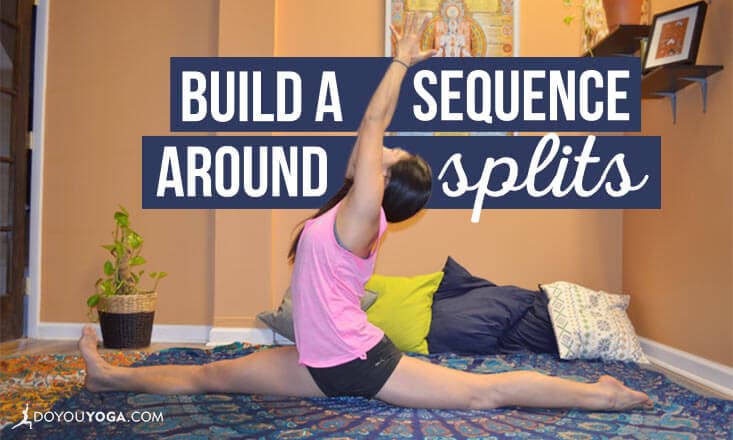The Year of the Monkey started February 8th, 2016 making this the perfect time to honor the Hindu monkey god, Hanuman, by practicing Monkey Pose, or Hanumanasana.
Practicing Hanumanasana channels the power from its namesake to build love and devotion within you and your practice.
“Lord Ram gave Hanuman a quizzical look and said, 'What are you, a monkey or a man?' Hanuman bowed his head reverently, folded his hands and said, “When I do not know who I am, I serve You and when I do know who I am, You and I are One.” – Tulsidas
Benefits
Hanumanasana has many benefits for the mind, body, and soul. The asana improves flexibility and blood circulation in the legs and hips. As you ease into the pose, the pelvic area becomes supple, allowing the weight of the hips to release tension from the back.
The asana stretches the thighs, hamstrings, and groin muscles and it stimulates and massages the abdominal organs. With arms overhead, this asana strengthens the spinal, arm, and core muscles. Gazing up with your drishti improves concentration and balance.
This movement also strengthens two chakras: Muladhara and Svadisthana. The Muladhara Chakra, the first/root chakra, is located at the base of the spine at the tailbone in back and the pubic bone in front. Hanumanasana brings us closer to Mother Earth, grounding and strengthening the core needs for survival, security and safety, are located in the Muladhara Chakra.
The Svadisthana, or second/sacral chakra, is located at the lower belly and inner pelvis. It is associated with water, flow, flexibility, and fun. Hanumanasana cultivates the relationship between yourself and others, allowing you to build healthy relationships and release repressed emotions.
This asana is not recommended if you suffer from a slipped disc, sciatica, hernia, and/or dislocation of the hip joint.
Movements to help open the hips, thighs, and groin muscles are best for preparation. Additionally, focusing on the breath helps fuel the internal fire needed to safely move into Hanumanasana.
Here's how to build a sequence around Splits:
Bound Angle Pose/Baddha Konasana
 Credit: Ling Beisecker
Credit: Ling BeiseckerA great stretch for the inner thighs, groin muscles, and knees.
Hold the pose for 5-10 breaths, continuously inhale while lengthening the spine, and as you exhale, reach the sternum forward to increase intensity.
Head-to-Knee Forward Bend/Janu Sirsasana
 Credit: Ling Beisecker
Credit: Ling BeiseckerA lengthening stretch for the spine, shoulders, hamstrings, and groin muscles. Focus on keeping the hips square and gaze with the drishti at the big toe to increase the stretch in the hamstring.
To increase the digestive benefit, flow in accordance with the colon movement, start with the right leg forward then the switch to left after 5-10 breaths.
Wide-Angle Seated Forward Bend/Upavistha Konasana
 Credit: Ling Beisecker
Credit: Ling BeiseckerWide-Angle Seated Forward Bend stretches the insides and backs of the legs to help release any remaining tension and stiffness. The feet remain flexed with toes sending energy toward the sky and back to the shins.
Index and middle finger may interlace around the big toes as you send your sternum forward.
Low Lunge Pose/Anjaneyasana
 Credit: Ling Beisecker
Credit: Ling BeiseckerThis asana strengthens the quadriceps and gluteus muscles as well as stretches the psoas and hips. The benefits continue as you expand your chest, lungs, and shoulders. This is a great final pose in the sequence because of the ease in transition from Anjaneyasana to Hanumanasana.
How-To
 Credit: Ling Beisecker
Credit: Ling BeiseckerStarting in Low Lunge with the hands on the mat, allow the front foot to slowly move forward until you feel a deep stretch throughout the groin, hips, and thighs. If you feel any pain in one specific spot versus a generalized region, lift out of the asana to protect yourself and the longevity of your practice.
It might feel inviting to have a block or two under the hip bones. Practice squaring the hips and lengthening the spine.
The front foot is flexed with the toes sending energy to the sky and back toward the shin.
Eventually, the arms may lift overhead and the drishti is in-between the palms of the hands. If you have full splits, feel free to place a block under the front heel to increase the stretch, being extra mindful to not lock out the knee if you are double jointed.
Hanumanasana is known as the ultimate test of leg and hip flexibility. After such an intense asana, it is good to do some counter stretching.
Seated Forward Fold/Pachimottanasana
 Credit: Ling Beisecker
Credit: Ling BeiseckerPachimottanasana releases stress from the lower back, hamstring, and hips. Additionally, it massages and tones the abdominal and pelvic organs and muscles.
Placing a blanket underneath the hips helps release the hamstrings.
Cow Face Pose/Gomukhasana
 Credit: Ling Beisecker
Credit: Ling BeiseckerGomukhasana stretches the piriformis, glutes, hips, and IT band.
This is a great position to help relieve any tension created from Hanumanasana.
Savasana
 Credit: Ling Beisecker
Credit: Ling BeiseckerRelease in the final pose to help balance the mind, body, and soul. In Savasana, focus on the selflessness and loyalty of the honorable Hanuman to help reap the nectar of the practice.
Savasana is a great time to connect his bravery, perseverance, strength, and devoted service into your own mind, body, and soul.
Have fun practicing, and comment below on your favorite ways to get in and out of Splits!


